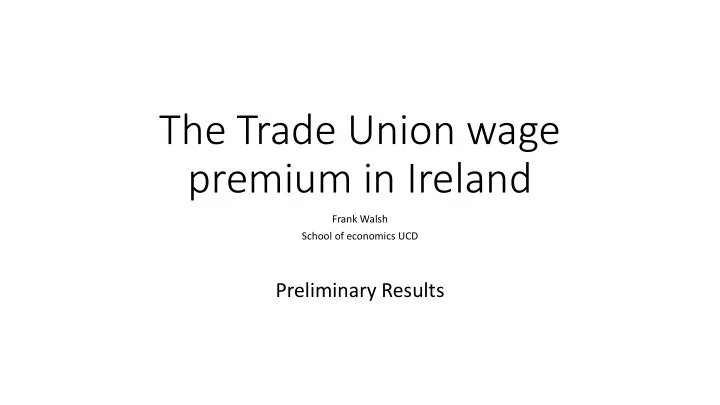

The Trade Union wage premium in Ireland Frank Walsh School of economics UCD Preliminary Results
Introduction • A large literature shows that members of Trade Unions earn substantially more than non members after controlling for worker and job Characteristics • Walsh (2013) using SILC data estimates a premium of around 10% (A little higher for public sector and lower for the Private sector). Employees only • The labour force survey shows a steady decline in the % of employees who are members over a number of decades • This is inline with international evidence, although not as clear that the share of jobs covered by union contracts is falling. No data on this for Ireland (that I know of) • Is the union wage premium holding up and how does it affect wage inequality
Trade Union Density: All Employees Note: this excludes self- .4 employed, unemployed .38 or retired union Trade Union Density .36 members .34 For SIPTU retired .32 members went from 4.2% in 1993 to 10.2% in .3 2016 .28 .26 Substantial share of 2003q2 2004q2 2005q2 2006q2 2007q2 2008q2 2009q2 2010q2 2011q2 2012q2 2013q2 2014q2 members excluded each year Date Share changes over time Source: Walsh (2014)IRN Labour Force Survey
Data • Earnings Analysis using Administrative Data Sources (EAADS), Matched with the Labour force Survey. Compiled by the CSO • Update of the data used in Public pay Commission report • 2011-2018 Annual data 113,905 observations • Earnings (from main job), weeks worked Public sector and Industry taken from P35 and administrative data sources • Other Controls: Age, Education, Gender, Weekly Hours, Job Tenure, Nationality, Region, Marital Status, Occupation and industry all from Labour Force Survey • Missing values are excluded from the data (This could cause selection bias)
Trade Union density EAADS data by Public Sector status .8 • The exclusion of missing values .6 means this is not the same as the CSO estimates from the Labour Force Survey .4 • Density seems to be higher in this .2 data and the trend is more 2010 2012 2014 2016 2018 negative than LFS since 2013 year All employees Private sector Public Sector Semi State
The Trade Union Wage Premium All Workers Private Public Weekly Wage Coefficient 11.6% 12.2% 6.9% 12.5% Observations 131,905 95,891 36,014 131,905 Rsquared 0.7661 0.7624 0.7038 0.6829 • Linear regression of Annual/Weekly earnings controlling for worker and job characteristics • Public sector (non semi-state) compares public sector union members with public sector non-members • All coefficients in all the tables in this presentation highly statistically significant
Oaxaca Decomposition of Union Wage Differential All Workers Private Public Difference 52.7% 36.8% 36.1% Endowments 41.1% 26.7% 26.9% Coefficients 10.7% 12.4% 4.6% Interaction 0.9% 2.3% 4.6% • Gross wage differential is big (especially for private sector employees) • Most of this is explained by differences in characteristics of the worker/job • Still a substantial “Unexplained” wage differential for union members
Unconditional Quantile Analysis [Firpo, Fortin and Lemieux (2009)] • If membership of Trade Unions were to increase by a little how would this affect different quantiles of the wage distribution • Conditional quantile analysis does not allow to answer this question • Using Unconditional quantiles make a substantial difference • In general in the literature trade unions tend to lower wage inequality
Quantiles 10% 25% 50% 75% Conditional Private 16.4% 14.3% 12.4% 11.4% Unconditional all 21.0% 23.5% 18.2% 5.3% Unconditional Private 18.5% 23.4% 20.0% 12.7% Private Weekly Wage 21.3% 19.3% 18.7% 13.2% Unconditional Public 34.0% 9.6% 2.8% 3.2% • Doing Unconditional vs Conditional quantile makes a substantial difference to the pattern • The analysis suggests a large Union wage premium across the wage distribution, especially up to the 50 th percentile • Also that an increase in Trade Union membership across the distribution would reduce wage inequality
Conclusions • Share of employees in Unions isin decline amongst employees (we have no evidence on coverage) • Density is low in the private sector (Although this data may have selection bias) • There is a substantial Trade union Wage premium on average and across the distribution and a smaller premium in the public sector • The evidence suggests that trade unions lower wage inequality • Unconditional vs Conditional analysis makes a substantial difference to the estimates
Additional Tables Summary Statistics EAADS data: 2011-2018 Name Mean Standard_Deviation Annual Gross pay €37,674 31,987 Annual weeks 47.86 9.31 Usual weekly Hours 34.48 10.37 % Union Member 0.33 0.47 %Public (Not Semi-State) 0.25 0.43 %Private 0.73 0.45 %Semi-State 0.03 0.16 Age 40.25 11.55 % Male 0.48 0.50 Years Tenure 10.28 9.33 %Irish 0.90 0.30 Number of Observations: 131,905
Unconditional Quantiles Oaxaca decomposition All Workers 10% 25% 50% 75% Difference 99.4% 78.2% 51.3% 32.7% Endowments 83.8% 51.2% 32.2% 20.9% coefficients 15.6% 27.0% 19.1% 11.8% Private Sector difference 72.2% 55.4% 35.2% 21.7% endowments 45.7% 35.5% 23.1% 16.5% coefficients 26.5% 20.0% 12.0% 5.2% Private Weekly difference 54.2% 41.6% 31.0% 19.1% endowments 25.9% 22.8% 18.7% 12.9% coefficients 28.3% 18.9% 12.3% 6.2%
Recommend
More recommend